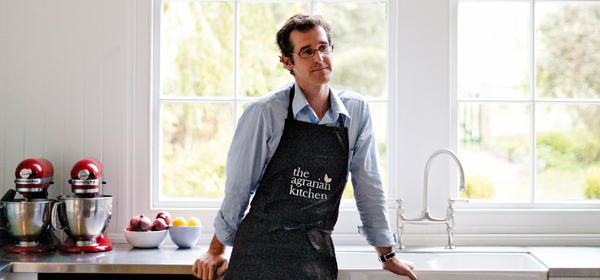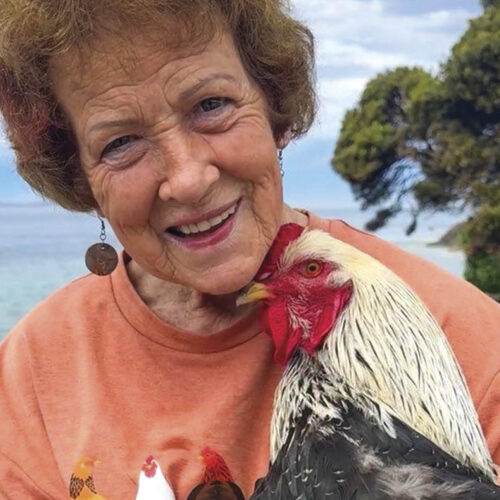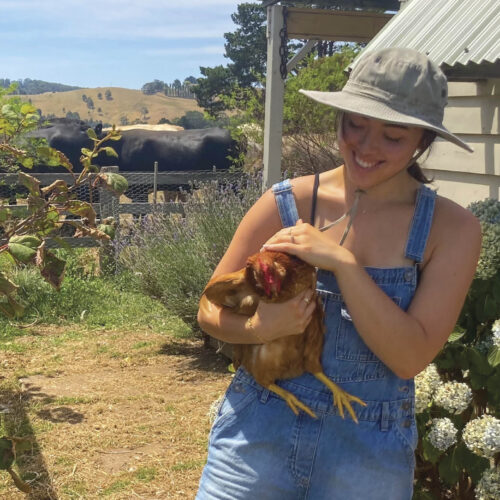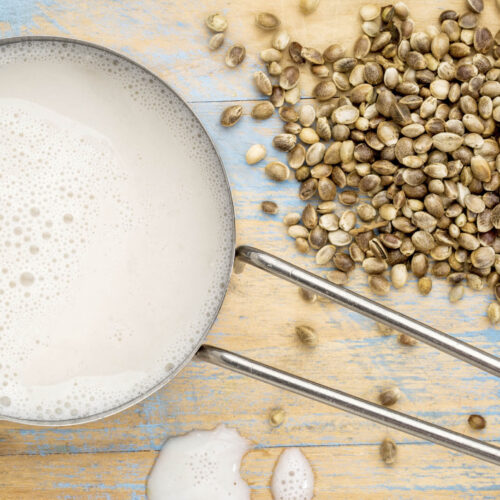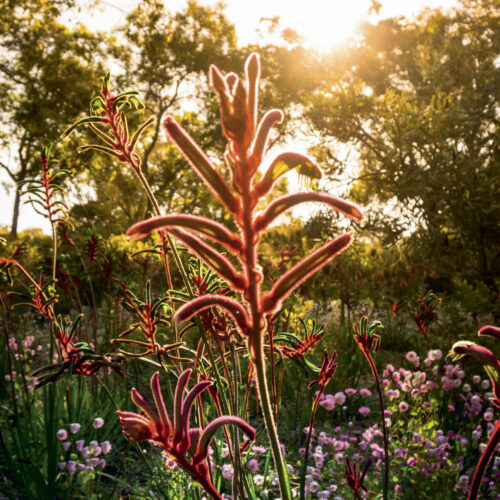A love of fields and food
2012-07-29T07:06:04+10:00
Food writer Rodney Dunn and his family are living their dream in south-eastern Tasmania, growing and harvesting their own produce. They are offering fellow foodies a chance to share the journey through their farm and cookery school, The Agrarian Kitchen. HELEN CUSHING paid them a visit.
“I was constantly thinking: how do you get better food? At a certain point I realised it doesn’t get better if you just keep buying the same produce from the same shop. The next obvious step was to reconnect with the land, to grow your own food.”
When this realisation came to Rodney Dunn, he was living in inner Sydney and working in a creative, dynamic job as food editor for a leading food magazine. He had also worked as a chef (he spent his third year as an apprentice chef at the renowned Tetsuya’s restaurant in Sydney), but knew nothing about farming and gardening.
He did know, however, that the inspiration to extend his passion for superb food into a more complete experience meant walking out of the kitchen door and into the garden.
The idea of integrating a sustainable organic farm with a cookery school was sparked by the River Cottage television series from the UK. “I wondered where I could do something like that. I’d never been to Tasmania until I came on a trip here for my job. Tasmania, I thought, could be such a place.”
Another incentive for Rodney and his wife, Séverine Demanet, was to raise their son Tristan, then a baby, in a more wholesome, free environment.
“We originally started looking for land in the Huon Valley, thinking we would build. Then we nearly bought at Hamilton. We’d never heard of Lachlan, and although the property had less land than I thought I wanted, we decided to go for it.”
Lachlan is a tiny village in the Derwent Valley, only 45 minutes drive from Hobart, and on the doorstep of the regional centre, New Norfolk. Here they had discovered two hectares complete with a 19th century schoolhouse. Although it had been retired from school life in the early 1960s, its original raison d’être meant there were two large classrooms divided by a movable wall – perfect for conversion into a 21st century farm-based cookery school.
With the help of a grant from the Tasmanian government’s Product and Experience Fund, The Agrarian Kitchen opened 12 months later, in 2008. Just two years on, in March 2010, the cookery school was placed number one in the Australian Traveller magazine’s list of 100 Greatest Australian Gourmet Experiences, ahead of many iconic award-winning restaurants. The idea was working.
Food and farming
The Agrarian Kitchen’s philosophy is encapsulated in the words of American farmer, writer and academic, Wendell Berry: “An agrarian mind begins with the love of fields and ramifies in good farming, good cooking and good eating”.
The massive task of realising this vision has involved establishing not only a state-of-the-art kitchen classroom, but also a small mixed farm, complete with free-range rare breed pigs, milking goats, geese, chickens, an orchard and vegie gardens. The cooking workshops and master classes are based around the farm’s harvest, supplemented by locally sourced products. The idea is to integrate the experiences of harvesting, cooking and eating into one enjoyable, shared journey. A range of workshops is offered, with specialists in baking, butchering and preserving brought in to supplement Rodney’s talents.
Enticing workshop titles, such as Cooking with Fire, Secrets of Sourdough, The Whole Hog, Tomato Gluttony and Preserving Summer’s Bounty, hint at the wholesome feasts to be had. The Agrarian Experience, however, is without a doubt the signature class, defining Rodney and Séverine’s inspiration.
A food lover’s dream
Claire McCarthy, a keen foodie who previously attended the iconic organic farm-based Darina Allen’s Ballymaloe Cookery School in Ireland, travelled from Sydney specifically to immerse herself in The Agrarian Experience.
“It was unbelievable. I’ve been raving about it ever since,” she says, in her delightful Irish accent. “It was very intimate – there were only eight in the group. We got there in the morning and were treated to blueberry muffins and coffee. Then we put on gumboots and milked the goats. Then we fed the glorious pigs, the beautiful pigs… next we fed the chickens, then went into the vegetable garden with our baskets and secateurs and picked zucchinis, as well as tomatoes off the vine that just explode with flavour when you put them in your mouth.”
The class consists of harvesting the food, preparing a seasonal feast based on the harvest and local produce, then sitting down together to enjoy the three-course spread, which includes bottles of fine Tasmanian wine and artisan ales.
Rodney goes for a wander in the garden the day before and comes up with a menu based on the ripest fruits, vegetables and herbs. Wild-harvested foods such as blackberries and mushrooms are also used, giving groups the opportunity to forage in the peaceful valley.
When Claire made the pilgrimage, autumn was just moving into winter. “What took my breath away was the vibrant colour of the apples on the trees,” she says. “Back in the kitchen, the menu started off with ravioli. We made the ricotta from the goat’s milk – what a beautiful experience.”
The menu is split between the group. “I made the pastry for the most gorgeous wild damson and apple tart,” says Claire. Damsons are a small blue cooking plum, traditionally part of English hedgerows and not uncommon in Tasmania.
Fired with love
The wood-fired oven is an essential part of the cooking school. “It was designed by Allan Scott and built by his son,” says Rodney. “Allan was the grand master of wood ovens, and this was the last one built in his lifetime. He spent his final years right here in Tasmania, in Oatlands. His obituary was in The New York Times.”
A little research reveals that Scott, born in Toorak, Victoria, studied agriculture, trained as a blacksmith, settled in California and was the key person in the revival of wood-fired ovens for baking.
The day Claire was at The Agrarian Kitchen, the main meal included aged brisket cooked in the wood-fired oven, accompanied by freshly harvested vegetables such as Jerusalem artichokes and potatoes.
Growing and learning
Growing the food is something Rodney and Séverine have had to learn. Séverine’s skills are in office administration, making her an invaluable part of the business team.
Their son, Tristan, now three, is growing up milking goats and getting muddy, but for his parents, the old schoolhouse at Lachlan is a long way from the ultra-urban life they lived in Sydney’s multicultural Newtown.
Without a harvest, there is no basis for the cooking classes, so the pressure to produce is very real. In the year before opening, the farmlet was designed and established with the help of Paul Healy, a Tasmanian organic gardener, writer and consultant on all things to do with self-sufficiency.
Wessex Saddleback pigs are used as ‘tractors’. An area of land is fenced off and the pigs are given free range, transforming it from pasture to pre-fertilised, turned soil, ready to be shaped into highly productive beds for vegetables, or grains like wheat and barley.
Rodney was after a rare breed, and the Saddlebacks are good mothers and producers. But despite helping to tractor the fields and living a good organic life, at nine months to a year they are destined for The Whole Hog master class, a two-day program that includes butchering a pig and using every part of it.
“The meat is completely different to anything you’ve ever had,” says Rodney. “Of course the quality is going to be different if the animal hasn’t been stressed in a factory-farming situation.”
Real food, real flavour
The vegetable garden is a place of colour, abundance and activity. In the cool months, small plastic igloos shelter fat, shiny aubergines and capsicums from the chills of the Derwent Valley.
Some 60 heirloom tomato varieties are laden with offerings in all shapes, sizes and hues – yellow, orange, pink, green, red, striped, long, tiny, curvaceous, enormous, pear-shaped and everything in between. And as Claire discovered, they are juicy flavour bombs, ready to burst upon deprived taste buds.
The aptly named master class, Tomato Gluttony, sends people home with bottles of pickles, paste, ketchup, chutney, passata and whatever else Rodney has come up with at the time.
And the pumpkin crop can be described along the same lines – an artist’s extravaganza of form, texture, colour and drama.
“I just try to grow things that are interesting,” says Rodney, in something of an understatement. As an example, he mentions Bartowich Long Parsley, which grows a parsnip-like root that can be roasted or grated into salads. Artichokes, asparagus, cardoons, celeriac, burdock, horseradish, salsify, kale and herbs of all persuasions are also regulars.
The bread- and pastry-baking classes are the only ones that don’t start in the garden, but the attendees do grind the flour in a mill.
As for the future, a smoke-house and root cellar (to be dug into a south-facing hill) are nearing the top of the to-do list. The orchard is young and needs expansion, although 10 varieties of raspberries, the wild blackberries, damsons and heirloom apples are already fruiting. It all makes for ripe and luscious days ahead.
Recipes by Rodney Dunn
Zucchini & Raclette Pizza – (Serves 4)
Topping
- 550g mozzarella, sliced
- 500g (about 3) small zucchini, with flowers (optional), thinly sliced lengthways
- 300g Raclette (or Tilsit or Gruyere) cheese, coarsely grated
- 1 tbsp coarsely chopped rosemary leaves
- Freshly grated parmesan, to serve
- Extra virgin olive oil for drizzling
Pizza dough
- 15g dried yeast
- 400g “00” plain flour* (or bread flour), plus extra for dusting
* An Italian flour also known as dopio zero flour - 1½ tsp of sea salt
- 2 tbsp extra virgin olive oil, for brushing
For the pizza dough, combine yeast and 40ml lukewarm water in a small bowl and stir until dissolved. Add 2 tbsp of the flour and stir until combined. Cover and stand in a warm place for 30 minutes or until foamy. Place remaining flour in a large bowl, make a well in the centre and add yeast mixture, sea salt and 200ml lukewarm water.
Mix ingredients together then knead on a lightly floured work surface until dough is smooth and elastic (8–10 minutes). Divide dough into 4 and place on a lightly greased oven tray. Brush with olive oil, cover with a tea towel and stand in a warm place until doubled in size (about 2 hours).
Place a pizza stone on the middle rack of oven and preheat on highest heat. Lightly dust a work surface with flour and, using fingertips, press out one piece of the dough to about 20cm in diameter. Arrange one-quarter of the mozzarella evenly over pizza base. Arrange one-quarter of the zucchini on top then scatter over one-quarter of the Raclette (or Tilsit or Gruyere) cheese and one-quarter of the rosemary.
Using a thin tray, slide pizza onto preheated pizza stone and cook until golden (4–5 minutes). Scatter over parmesan and drizzle with extra virgin olive oil. Repeat with remaining dough and toppings.
Rhubarb & apple pies – (Serves 4)
Filling
- 500g apples, peeled and cut into 1cm pieces
- 1 tsp vanilla paste
- 125g caster sugar
- 55g (¼ cup) raw sugar
- Vanilla ice-cream or double cream, to serve
Shortcrust pastry
- 315g plain flour
- 175g butter, cut into 2cm pieces
- 60g caster sugar
- 1 egg yolk, beaten
- 1 eggwhite, beaten, to brush
For shortcrust pastry, place flour, butter, sugar and a pinch of salt in a large bowl and, using your fingertips, rub in butter until mixture resembles coarse breadcrumbs. Add eg yolk and 2 tbsp iced water and gently knead until mixture just comes together. Form pastry into a flat disc, wrap in plastic wrap and refrigerate until chilled (about 1 hour).
Meanwhile, combine rhubarb and apple in a large saucepan, add vanilla and scatter caster sugar on top. Add 1 tbsp water and bring to a simmer. Taste and add more caster sugar if necessary. Cover and cook over low heat until apple and rhubarb mixture is soft and moisture has evaporated. Set aside to cool.
Roll out two-thirds of the pastry on a lightly floured work surface to 5mm thickness. Line four 8cm-round pie dishes with pastry and refrigerate for 30 minutes. Preheat oven to 190°C. Place cooled filling into pie dishes. Roll out remaining pastry to circles large enough to cover the tops of the pie dishes. Cover, pressing edges together to seal.
Make a small hole in the centre of each pie (this allows the steam to escape while baking) and brush tops with eggwhite, then scatter with raw sugar. Place pies in the refrigerator to rest for at least 30 minutes before baking.
Bake pies for 20–30 minutes or until golden brown. Serve warm with vanilla ice-cream or double cream.

